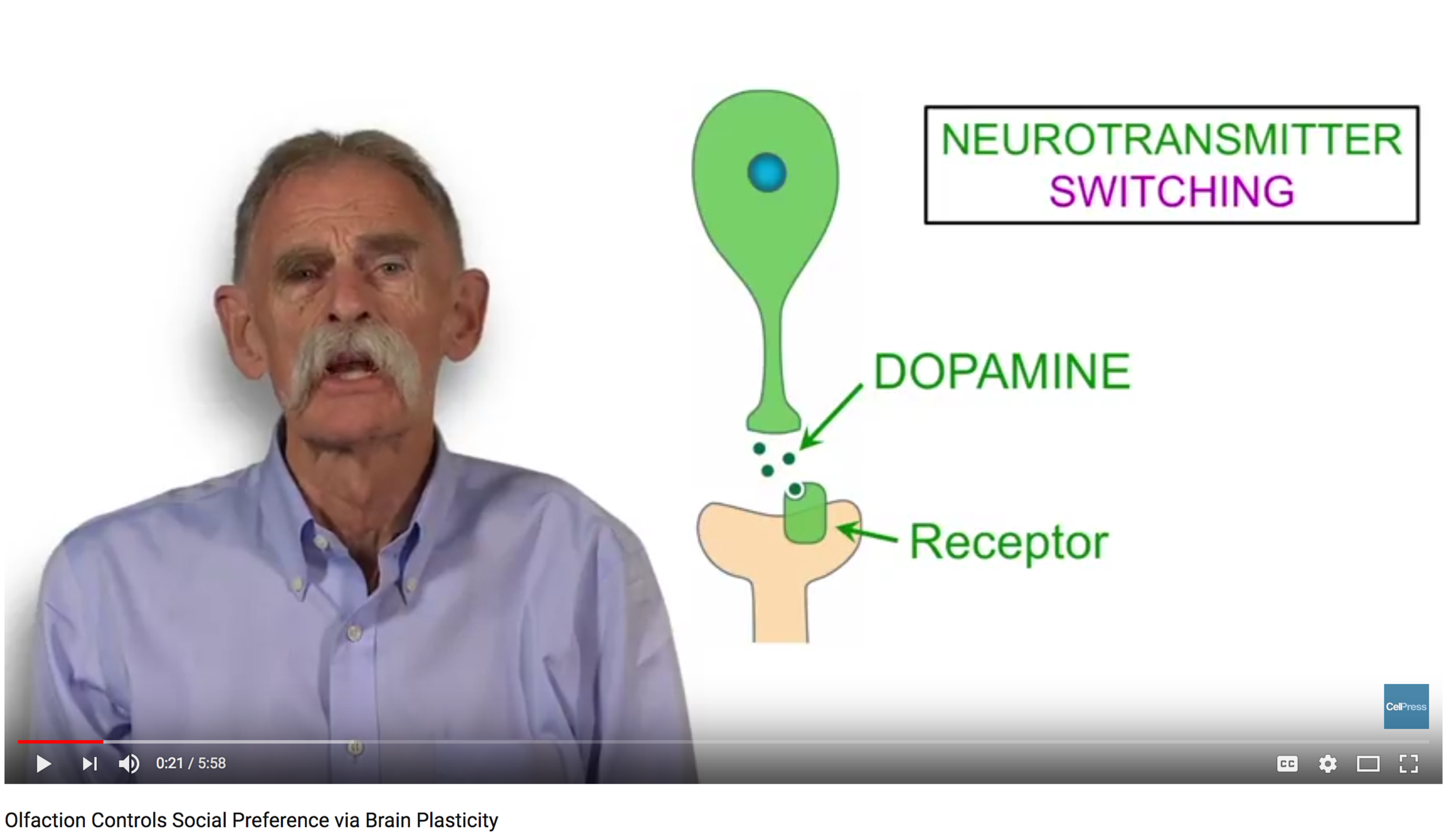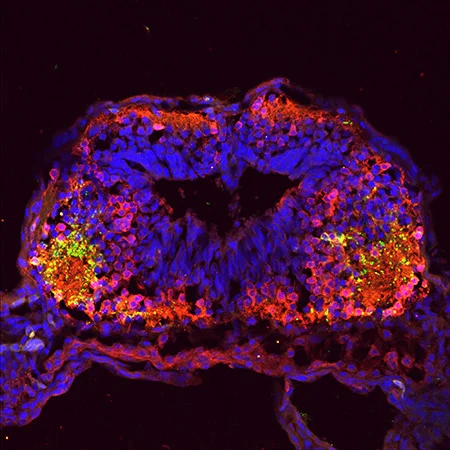Shaping Early Networks to Rule Mature Circuits: Little MiRs Go a Long Way
/From: Neuron Preview (Dec 21, 2016). Authors: Andre Marques-Smith, Emilia Favuzzi, and Beatriz Rico
Normative cortical processing depends on precise interactions between excitatory and inhibitory neurons. In this issue of Neuron, Lippi et al. (2016) identify miR-101 as a master regulator coordinating molecular programs during development that ultimately impact the activity of mature networks.
Main Text
Neural computation relies on the precise organization of synaptic connections among different neuronal subtypes. Interactions between excitatory pyramidal neurons and inhibitory GABAergic interneurons are particularly important, as neuronal circuits can only operate effectively within certain bounds of excitation and inhibition (Isaacson and Scanziani, 2011). This is critical not only for the information processing that supports animal behavior but also because overstepping these boundaries can lead to neurodevelopmental and neurological disorders, including autism, schizophrenia, and epilepsy (Paz and Huguenard, 2015, Marín, 2016).
During brain development a plethora of turbulent events will frame mature neural circuits: endogenous spontaneous rhythms give way to sensory-driven activity, GABA switches polarity, canonical circuits are formed, potentiated, and refined, and eventually synapses elevate their threshold for plasticity, narrowing integration windows to become fast, precise reporters of spiking activity. Each of these processes is regulated by dynamic programs of gene expression, which are tuned by neural activity in a bidirectional manner. What could quickly become a neural cacophony actually plays out as a beautifully orchestrated symphony; transcriptional programs regulate expression of ion channels, neurotransmitter receptors, and transporters, restraining patterns of network activity and controlling the transition between them. The intimate association of several such developmental processes—e.g., dendritic arbor elaboration and synapse formation—and the need to concertedly switch transcription on or off for different genes requires centralized regulation of gene cohorts to effect on-going neural genetic programs. MicroRNAs (miRs) are small non-coding RNAs that function as post-transcriptional regulators of gene expression holding the ability to simultaneously regulate multiple genes in the context of complex regulatory networks (McNeill and Van Vactor, 2012). miRs provide mechanisms of regulation that are fast, flexible, and reversible and as such, well-suited for the complexities of neural circuit wiring. They appear thus as ideal candidates to tightly regulate and tune developmental gene programs during the assembly of neuronal circuits. In a series of elegant experiments, Lippi et al. (2016) discover that microRNA 101 (miR-101) synergistically regulates expression of several genes for the common goal of constraining excitation in hippocampal circuits.
Lippi et al. (2016) carried out a thorough screening to identify sequenced miRs in the developing hippocampus at postnatal day 12 (P12), a critical developmental window, curating a list of candidates well suited for neural developmental processes. Then, based on: (1) abundance, (2) upregulation during development, (3) enrichment in Argonaute complexes (Ago, effector of miR function), and (4) published targets of miRs involved in neural differentiation, they identified miR-101. Transient (P2–P9) and localized inhibition of miR-101 resulted in a lasting adult phenotype characterized overall by hyper-excitability. Adult hippocampal pyramidal neurons displayed increased firing rates in vivo, as well as elevated frequency and amplitude of spontaneous excitatory post-synaptic currents (sEPSCs) in vitro. Calcium imaging experiments revealed higher proportions of active neurons at any one time, as well as an overall increase in frequency of calcium (putative spiking) events. By using behavioral tests that depend on hippocampal function, Lippi et al. (2016) showed that blocking miR-101 in early postnatal life—but not in adult—led to lasting deficits in context-dependent associative memory, spatial working memory, and spatial episodic-like memory. These findings are particularly relevant for neurodevelopmental disorders, as they link the transient early inhibition of miR-101 to impaired cognitive function in the adult.
To identify the mechanism by which miR-101 regulates the establishment of a balanced network, they searched for miR-101 targets. Using a combination of in vitro and in vivo approaches, Lippi et al. (2016) revealed several candidates, including the sodium-potassium-chloride co-transporter 1 (NKCC1). Across multiple brain regions, downregulation of this chloride importer and upregulation of the chloride exporter KCC2 underlies the developmental shift in chloride reversal potential and consequent maturation of GABAergic signaling from depolarizing to hyperpolarizing (Ben-Ari, 2002). Indeed, blocking miR-101 in vivo resulted in increased NKCC1 expression by release from miR-101 repression and a relatively depolarized EGABA at P8. In contrast, KCC2 expression was unchanged, suggesting that a distinct developmental genetic program regulates KCC2 levels. By disrupting miR-101-NKCC1 interaction without affecting other miR-101 targets, Lippi et al. (2016) elegantly demonstrate that miR-101 regulation of NKCC1 mRNA alone was responsible for the delayed maturation of the GABA reversal potential. Giant depolarizing potentials (GDPs) synchronize activity and promote synaptic plasticity between pyramidal neurons (Allène et al., 2008). Furthermore, early GABAergic activity is required for dendritic elaboration (Cancedda et al., 2007). Therefore, a sustained depolarizing action of GABA in miR-101 blocking experiments could affect both synaptic stabilization and dendritic development leading to an exuberant excitatory network. However, specific de-repression of NKCC1 without affecting other miR-101 in vivo only explained the increased rate of synchronous calcium events and a modest elevation in miniature EPSC frequency in vitro, causing no discernible effect on overall rate of calcium, proportion of active ensembles, or double synchronized events, hallmark features of the miR-101 phenotype.
Given the partial phenotype of prolonged NKCC1 expression, Lippi et al. (2016) hypothesized that the effect of miR-101 inhibition was achieved through multi-level targeting of several genes within a biological network. They explored this possibility by combining the top targets for miR-101 into groups, according to their known developmental ontology effects (“Pre-synaptic,” “Glial,” and “Excitability”). In addition to NKCC1, the “Pre-synaptic” group included two genes involved in the formation and stabilization of presynaptic inputs, Ank2 and Kif1a. Lippi et al. (2016) elegantly dissected the contribution of these genes, finding that NKCC1 targeting by miR-101 limits dendritic length while complementary repression of Kif1a and Ank2 is required to restrict excitatory synaptic density. As a result, continued expression of NKCC1 and the genes in the “Pre-synaptic” group mimicked the increased levels of activity, mainly because of the occurrence of more asynchronous calcium events. Next, de-repression of NKCC1 and two genes, the cholesterol transporter Abca1 and the hydrolase Ndrg2 (“Glial” group), enriched in glial cells with a role in neurite growth, was responsible for the increase in the size of cell ensembles recruited in each synchronous event. Releasing the expression of genes involved in regulating neuronal excitability (“Excitability” group), along with NKCC1, increased the number of double events. Thus, each group of genes accounted for unique aspects of the multi-tier regulatory control of miR-101 and together they dictate the precise code for a balanced development of neural circuits (Figure 1).
Although previous studies have proposed that miRs function in shaping the neuronal landscape (see McNeill and Van Vactor, 2012), the work of Lippi et al. (2016) constitutes the first demonstration that simultaneous regulation of multiple target genes by a single miR during a critical developmental window orchestrates convergent molecular programs that ultimately sculpt a stable mature neuronal network (Figure 1). Also, it is important to emphasize that this study has been carried out using in vivo models where the cellular context is intact, demonstrating a more physiological function of the miR. In sum, Lippi et al. (2016) reveal here a set of interesting results with implications not only for miR biology and function, but also for the regulation of excitatory-inhibitory balance and neurodevelopmental processes.
Figure 1.
miR-101 Regulates the Development of Neural Circuits Shaping Mature Networks in Adult.
It remains unknown why the long-lasting effects caused by early transient miR-101 blockage were not compensated homeostatically. It is well documented that neurons and networks are highly reactive to, and capable of compensating for, changes in their excitatory-inhibitory environment (Xue et al., 2014). It is surprising therefore that the hippocampal network did not respond to unfettered excitation through release from miR-101 regulation by increasing inhibition. Indeed, increases in excitation occurred in the absence of proportional changes in inhibitory currents, suggesting the presence of exuberant excitatory circuits rather than dis-inhibition. This is particularly intriguing since miR-101 is also expressed in interneurons. Interestingly, the lack of epileptiform activity in such an excitable network in itself suggests that subtler forms of compensation occurred and went undetected, preventing the emergence of pathology. An attractive possibility is that miR-101 itself regulates inhibitory synapse formation while it constrains excitation, and blockade of its action prevented emergence of an inhibitory compensatory response. It will be interesting to determine the role of miR-101 in different types of GABAergic cells. Inhibition synchronizes and sharpens excitatory responses in many brain areas, and its impairment could increase “noise” in learning and cognition, partially accounting for some of the observed cognitive effects of miR-101 inhibition described by Lippi et al. (2016).
What determines the changes in the expression of miR-101 in the first place? Is it the result of specific activity patterns or is it intrinsically determined? Pyramidal neurons receive inhibition in proportion to their afferent synaptic excitation levels, meaning E/I balances across cells are stable even though afferent excitation levels differ widely (Xue et al., 2014). How does the genetic regulation of E/I balance, through miR-101 and other actors, operate at the individual cell level? The simplest hypothesis is that genes regulating E/I balance are responsive to neural activity. miRs have indeed been previously linked to activity (McNeill and Van Vactor, 2012). Could miR-101, for instance, sense chronic increases in excitatory activity and increase repression of its downstream targets?
Additional work will be needed to examine whether miR-101 plays a similar role in other brain regions such as the neocortex. This will help to determine whether the regulatory developmental program described by Lippi et al. (2016) represents a general mechanism to constrain excitation in the brain. This is particularly relevant since neural circuits show exquisite fine structure, with spatially proximal cells often participating in completely different microcircuits and subnetworks (Lee et al., 2014). These channels of information may not have the same ratio of excitation and inhibition and may differentially impact neural function. Could miRs help sculpt an additional level of circuit-specificity, beyond cell-type rules of innervation? Some data in Lippi et al. (2016)’s work hints at pathway-specific regulation, e.g., discrepant effect of NKCC1 de-repression on the secondary branches in CA1 and in CA3 or over-representation of mossy fiber input. It would be of great interest to extend these observations with pathway and cell-type-specific methods.
Because of its ability to regulate multiple key aspects of brain development, it is not surprising that miR-101 has a role in many neuropsychiatric disorders (Lippi et al., 2016, Figure 1). Interestingly, the prevalent view in the field is that although development is a continuous process, there are specific sensitive windows—“critical periods”—in which modifications in network organization have long-lasting impact over the lifespan (Marín, 2016). These sensitive periods are pivotal milestones for the assembly of excitatory and inhibitory circuits. Therefore, understanding how the relative bounds of excitation and inhibition are developmentally established, maintained, and shifted is an exciting topic of research, increasingly attracting interest in Neuroscience. Indeed, unveiling the main regulators of these processes might be key for early interventions to restore normal brain function (Marín, 2016). Future work uncovering the function of miRs in neural circuit development promises to shed light on potential therapeutic targets for neurodevelopmental disorders.
Acknowledgments
Work in B.R. laboratory is supported by the European Research Council (ERC-2012-StG 310021). B.R. is Wellcome Trust Investigator.







